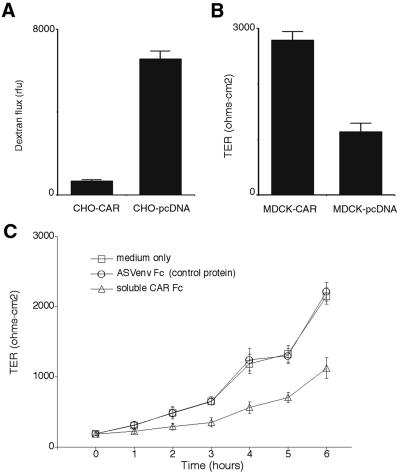Figure 3.
CAR is a barrier to paracellular solute and ion movement. (A) FITC dextran flux was measured across CHO cell monolayers. Confluent monolayers of CHO-CAR and mock-transfected CHO cells were grown on transwell membranes. FITC-labeled dextran was added to the upper chamber and after 2 h, aliquots of fluid from the lower chamber were collected and assayed by fluorimetry. Graph shows mean and standard deviation for triplicate monolayers. Results are representative of three experiments. (B) TER of MDCK cell monolayers. Confluent monolayers of mock-transfected (MDCK-pcDNA) or CAR-expressing MDCK cells were grown on Transwell membranes at confluency for 5 days. TER was measured with an epithelial voltohmmeter. Graph shows mean and standard deviation for quadruplicate monolayers. Results are representative of three experiments. (C) Soluble CAR inhibits the formation of tight junctions. Monolayers of T-84 cells were exposed to EDTA to disrupt tight junctions. EDTA was replaced with medium alone, medium containing 5 μg of soluble CAR, or medium containing 5 μg of the avian sarcoma virus envelope protein [ASVenv Fc (control protein)]. The TER was measured as an indication of tight junction reassembly. Graph shows mean and standard deviation for triplicate monolayers. Results are representative of three experiments.

